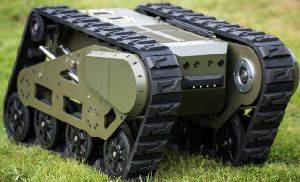Articles >>
BAE Systems` new Unmanned Ground Vehicle takes on dangerous jobs
Category: Robots

On display at DSEI this year, Ironclad™ is a new Unmanned Ground Vehicle (UGV) designed to take on some of the most dangerous jobs that soldiers currently face. Ironclad is small enough to negotiate tight urban environments, but maintains the mobility needed to handle extreme cross-country terrain. It can also be fitted to carry out reconnaissance, combat and casualty evacuation roles. Craig Fennell, Future Programmes Director at BAE Systems Land (UK) explained: “Ironclad has a unique set of capabilities for a UGV. Using high endurance battery power, it offers near silent running up to a 50km range and will come with a set of mission systems that can be quickly changed in the field. A modular connection system allows two vehicles to be connected together to handle additional loads, such as a specialised stretcher. It is also protected against blast and small arms fire to increase mission survivability.” “The next step is for Ironclad to act autonomously as part of a battlegroup, interacting with other vehicles and ground troops to follow mission objectives. This is being tested on existing vehicles as the technology – already at a high state of readiness – is developed.” Each Ironclad is built with a hardware interface that allows the different mission fits to be attached easily. This connection supplies both power and command from the main vehicle chassis, which houses the battery and a two-way remote control unit. The chassis is designed so that hardware needed for autonomous capability can be added at a later stage. Mission fits currently in development
Craig Fennell summarised what Ironclad offers: “Ironclad – while being a product in its own right – is also a step towards the battlefield of the future where we expect fleets of unmanned air and ground vehicles to work together, sharing situational awareness and pursuing combat objectives. There will always be a human in the loop, but increasing use of autonomy and unmanned vehicles means they can focus on key decisions and have more options to avoid putting people in dangerous situations.” |
BAE Systems |
BAE Systems` CV90 increases lethality by testing SPIKE LR anti-tank guided missile
14.01.2020
U.S. Marine Corps orders more Amphibious Combat Vehicles
11.11.2019
RAVEN Countermeasure System protects vehicles from missile threats
15.10.2019
BAE Systems unveils Robotic Technology Demonstrator Vehicle at AUSA
15.10.2019
BAE Systems Land Systems Hagglunds AB
BAE SYSTEMS Advanced Technology Centre
BAE SYSTEMS Customer Solutions & Support Land & Sea
BAE SYSTEMS Operational Training
BAE SYSTEMS RO Defence Small Arms Ammunition Division
BAE Systems North America, Land & Information Systems
Ironclad (Robot, Unmanned Vehicle)
Discuss
